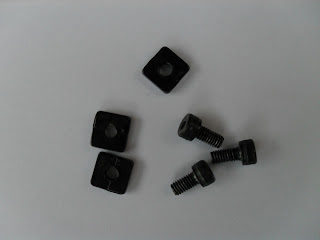This post is on the latest version of my pedal board. I've designed this board for a killer guitar tone using mostly true-bypass pedals and a couple of old buffered pedals.
The first thing the guitar signal goes into is a Korg Pitchblack tuner. This is a no frills, true bypass tuner. It has much better tracking and accuracy when compared to something like a boss TU-2 and costs around half the price. Also due to being true-bypass it wont suck your tone like most tuners.
The next pedal the signal goes into is a Maxon OD-9. This pedal is based on the original Maxon Tube Screamer circuit and in my opinion is the best version of the tube screamer, ever. The Tube Screamer which was originally produced by Maxon was later sold to ibanez who have basically taken all the fame since then. There are many versions of the Tube Screamer and many mods out there to solve various issues with pedals e.g. a drop on bass or lack of true-bypass or added noise to the rig. This version has solved all of these problems and does not need any of the various mods supplied on the internet. This pedal can produce all manor of overdrive but in my rig is set to provide an extra crunch and boost to my already dirty amp. This results in a gorgeous and responsive lead tone perfect for blues solos and a Jimi Hendrix esque sound.
The next pedal in the chain is a Proco Turbo Rat. This is very similar to the rat 2 but is designed to give a more tube like feel. I use this pedal for searing distortion and a psychedelic style Jonny Greenwood lead/solo sound. This pedal is also true-bypass and along with the maxon i can get almost any overdirve/distortion i need.
Next my guitar signal goes into a Keeley true-bypass looper. This either sends my signal straight on to the last pedal in the chain or sends it through an alternative buffered bypass loop. I use this to take my non true-bypass pedals out of the loop when not using them and it also enables me to switch my delay and flanger on with one click if i wish.
When Buffered loop selected:
After the Keeley is my Boss BF-2. This is a good analogue flanger made in 1982 in Japan. Although it lacks the features of more modern Flanger it is known for having a more natural a smoother sound. I use this pedal occasionally just to add a bit of a chorus style shimmer to my sound.
The second and last pedal in my buffered loop is a blue label Boss DD-2.tMade in 1984 his is the first digital delay made by Boss and is quite rare. This pedal is fairly basic with the three standard 50,200 and 800 ms delay time and a hold mode. This blue label example houses the original long chip known for a more natural and almost analogue delay sound. When these "long" chips ran out the DD-2 was renamed as the DD-3. I use this pedal for a bit of slapback or a stadium sort of sound for lead and solos.
This signal then goes back into the Keeley looper then into the last pedal; so the looper includes or excludes the flanger and delay then sends the signal to the next and final pedal.
The last pedal in my true-bypass loop is a Creation Audio Labs MK 4.23 Boost. This boost pedal does not alter the eq of your sound in any way. It just has 0-24 db of clean transparent signal boost. This pedal can be used as a volume booster or it can be used to drive a valve amp slightly harder. I use this pedal as a signal buffer at the end of my chain simply to keep my guitar signal nice and strong and to get a sweet natural crunch out of my amp. This really does make a world of difference.
Everything is powered by a Dunlop DC brick and there is also a footswitch to turn the reverb and tremolo on my amp on and off.

























